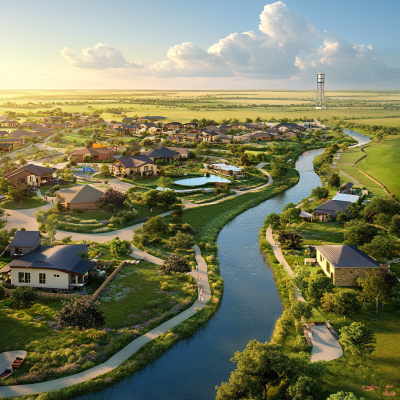Texas: The New Frontier for Big Tech
Texas now ranks second only to Virginia for total data centers. These sprawling facilities power artificial intelligence and cloud computing for companies like Google, Meta, and Amazon. Until recently, they clustered around Dallas and other metro areas. But now, developers are expanding into smaller markets such as Amarillo, Pampa, Sulphur Springs, and Odessa.
The appeal is simple: vast land, strong energy infrastructure, and local leaders eager to attract new business. For rural regions that have long relied on agriculture or oil, data centers seem like a new economic lifeline — a chance to diversify and modernize.
Economic Promise: Jobs and Local Investment
Developers argue that data centers can be engines of economic growth. In Amarillo, Fermi America co-founded by former Texas Governor Rick Perry plans a 5,800-acre AI data campus that could bring hundreds of high-paying tech jobs. “The deployment brings tremendous growth and stability to our community,” said Trent Sisemore, Fermi’s community engagement lead.
In Ector County, Judge Dustin Fawcett welcomes similar projects. He says data centers could help repurpose natural gas and “produced water” from oil operations. “It’s exciting when it comes to data centers,” Fawcett said. “We get to be more efficient with the products we’re mining.”
For local governments, the benefits are tangible: tax revenue, infrastructure improvements, and the attraction of new skilled workers.
Environmental Cost: Water, Noise, and Uncertainty
Critics say the price of progress may be too high. Data centers consume millions of gallons of water per day to cool their systems. In drought-prone regions like the Texas Panhandle and Permian Basin, that’s a serious problem.
Residents worry about the strain on the Ogallala Aquifer, which sustains farming and ranching across the High Plains. Competing industrial demand could threaten the region’s agricultural backbone. “Wealth here is the water,” said Will Masters of Ogallala Life, a nonprofit focused on aquifer conservation. “If the water is not here, this area is impoverished.”
Noise, power demands, and the potential for pollution also top the list of local concerns.
Community Pushback Grows
In Amarillo, residents are leading protests against the proposed data center projects. Many moved to rural Texas for its peace and simplicity, not to live next door to industrial-scale server farms. They’re looking at examples in Virginia and North Carolina, where communities saw water shortages and rising electricity costs after similar developments.
Experts add that Texas currently lacks statewide water-use regulations for data centers. That gap leaves local governments scrambling to balance growth and conservation.
Yi Ding, a Purdue University engineering professor, warned that newer cooling technologies might not solve the issue entirely. “When something becomes more efficient, people use it more,” she said. “Total water consumption doesn’t drop unless there’s a real shift in cooling methods.”
Finding Balance: Progress and Preservation
City leaders say they’re listening. Amarillo Mayor Cole Stanley confirmed that any water deal with Fermi America will prioritize resource protection and long-term sustainability. Developers promise to use closed-loop cooling systems that recycle water to reduce waste.
If successful, these models could shape how rural communities adapt to the tech-driven economy. Still, the central question remains: Can economic opportunity and environmental responsibility truly coexist?
The Bigger Picture: What’s at Stake for Rural Texas
The data center boom is redefining what “progress” means in rural Texas. Economic growth brings jobs, but also competition for limited natural resources. For landowners, investors, and REALTORS®, understanding this shift is crucial. Property values, zoning, and water access are now deeply connected to the state’s tech expansion.
Texas has always led by innovation but its future may depend on whether communities can build a digital economy without draining the natural one.
Looking to invest in rural Texas land? Learn how to evaluate property potential, zoning, and water rights before the next data wave hits.




